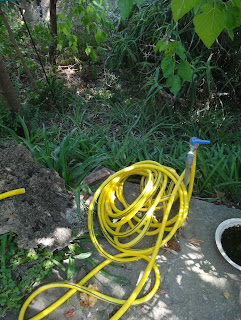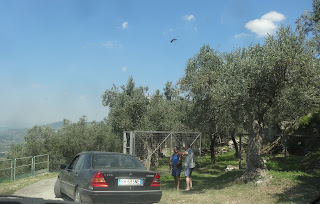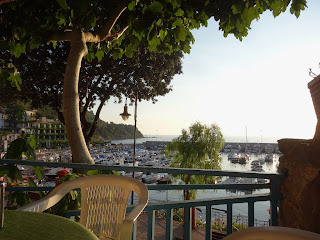 |
| Our favorite no-cook dinner, or at least we-don't-cook dinner |
 |
| The terazza, usually shady and breezy, but not for the last 10 days |
 |
| No-cook lunch |
 |
| Thank God for good old fans |
 |
| Cioppo knows the right way to spend the afternoon. |
 |
| These guys love the heat and humidity |
 |
| Part of Agropoli's beach |
 |
| Or, there's always the hose. |
“We’re having a heat wave, a tropical heat wave, the temperature’s rising, it isn’t surprising that it’s hot as Hades.” You oldsters will know the tune, though I must apologize to Irving Berlin for desecrating his lyrics. Things have been toasty here in the Cilento of late. We are on the periphery of the third major European heat wave of the last 15 years. Based on the last hundred years of climate data, the chances of that happening are astronomical. You draw your own conclusions about climate change from that. As far as I’m concerned, anyone who is still in denial is either an idiot or is willfully ignorant. Strong emphasis on the ‘willfully’.
The heat wave in the Continental Zone (we are in Mediterranean Europe) is quite impressive. On Monday, June 29, Madrid hit 104°F. The previous day Cordoba, down in the south of Spain, reached a mind-boggling 111°. Wednesday of the same week, a temperature of 98° was recorded at London’s Heathrow Airport. In London! So far, three all-time highs have been reached in France, at Boulogne-sur-Mer (96), Dieppe (101) and Melun (a balmy 103).
Just this week, Madrid reached 104°. Germany reached an all-time high in that country, 104.5 at Kitzingen, and last weekend Berlin reached 100.2, Frankfurt 102.2. In Rome, temperatures have not been quite so extreme, but last week and this they have hovered in the low to mid 90s.
I shouldn’t complain. Here in Agropoli we have flirted with 90 all week, though this is the first day we’ve actually hit it. But the breeze has been consistent in the morning, and that helps tremendously. Sadly, our typical evening breeze has deserted us on several occasions, and that’s when we need it most, after the heat of the day. Perched as we are here between the mountains and the sea, we typically have a morning breeze, the venticello, ‘little wind’, which blows down from the hills, and an early evening breeze, the ‘across the mountains’ tramontana, which blows off the sea. And in the summer here in the South we still believe in the traditional early afternoon rest, the riposo. Another smart idea we owe to the Romans, by the way. The fancy Latin term is meridienation. The next time your spouse complains that you’re napping, just tell them you’re simply meridienating. That’ll shut ‘em up. Stores open early, usually by 8 am or earlier, depending on what they sell, and stay open till 12:30, when everyone goes home for some pranzo and perhaps a brief snooze, and then the stores open again around 4 pm and stay open till 8:30 or so. Total sanity, in my opinion. And folks are serious about their riposo in this part of the world; a neighbor town, Controne, about 30 miles north of here, recently passed an ordinance banning barking dogs during the sacred afternoon nap. Dog owners can now be fined up to 200 euros if Fido doesn't keep his yap shut between 2 and 4 in the afternoon. The ban evidently resonated with lots of Italians; the story made the national news.
In Continental Europe, where the bulk of that monster high pressure system resides, the heat has been absolutely deadly, especially for the old and infirm. You must remember that large portions of Europe, even in Italy, and even down here in the Mezzogiorno, are not air-conditioned or at least not widely so. I have not seen statistics for this wave, but in the deadly 2003 heat wave, some 30,000 Europeans died, 14,000 in France alone. The Weather Channel fixates on hurricanes and tornadoes because they create ratings, but even in the States, heat is far and away the greatest killer in nature.
So I’m very grateful for several things. First of all, the heat wave stayed away from Italy until after our tour. I had practically promised those good folks some delightful weather in mid-June Italy, and Italy delivered: temperatures in the high 70s and low 80s during the day, mid to low 60s at night. We had one brief rain shower when we arrived in Rome, a pretty steady downpour the afternoon of our last day in Venice, and otherwise the skies were blue, the humidity low, the breeze delightful, and the sun shining. Whew!
Secondly, I’m thankful we really are on the periphery of the high system. In many places the heat is a danger; here it is just an inconvenience, more of an irritation. And finally, I’m glad I grew up in the Mississippi River swamps of West Tennessee in an era before air conditioning, so I pretty much know the drill.
First of all, you just have to slow down and make some concessions to the heat. Want to get out? No problem, just plan on doing so before 1 pm or after 6 pm. And remember, people will be abroad until at least 1 in the morning. Want to cook? Don’t even think about it until about 8 pm. Better, enjoy the incredible fresh bounty of vegetables and fruits here. A slice of prosciutto on melon, or a Caprese salad with the local mozzarella di bufala, basil and the plum tomatoes that are so impossibly red and sweet, and you have a dinner fit for a king. Or how about aqua sale, a dish composed of chunks of bread that have been dipped in brine, then dried till they're hard as a brick. You run them under the faucet and count, "One Mississippi, two Mississippi," and the put them on a plate, wait about five minutes to let the bread rehydrate, and then cover them with those same cherry tomatoes, maybe mixed with a little olive oil and torn basil leaves or oregano. Trust me, it sounds strange, but it's delicious. A little vino, preferably mixed with ample water and maybe even served over ice, and you’re all set. And absolutely, feel free to refrigerate your red wine. Better yet, just go out for a good pizza. And remember that the dining hour at restaurants starts at 9 and goes to 12, when the coolness of the night allows for the best sauce of all, meeting with your friends and celebrating life.
Of course, we were strictly spoiled when I was a kid. Thanks to TVA, we had cheap electricity in Martin, Tennessee, and that meant fans. Good old fans! I still remember the monster window fan that was parked in a window at the western end of the house at 204 University Street, drawing a nice breeze through the open windows in the bedrooms on the east end and through the kitchen and living room, which back then was really a room where the family lived. Then there was this crazy little fan housed in a cylindrical, sturdy plastic cage which sat on the floor and blew the air up, sucking in the coolish air off the floor and stirring that hot air up near the ceiling. It looked like a cylindrical ottoman or hassock and I seem to recall that in the spring and fall we sometimes threw a circular pillow on it and used it as such. The top was composed of a grid of tiny plastic squares through which the cool air rushed. Until someone yelled at you to scram, you could crouch on the floor, lean over that little guy, and just let the cool air rush across your burning face. My poor, gullible sister nodded off on it one time and woke up with the grid impressed on her cheek; her mean old brother told her it was permanent, after which she went wailing to mama, as usual.
If the house fans were not cutting it, there was always the fan on wheels, also known as our 1962 blue Plymouth sedan. You packed the whole family in the old girl and headed out through the sweltering countryside as fast as you dared go—and Doctor Thurmond dared to go darned fast—with all the windows down and the air whistling through. Even better, cars back then came equipped with a small, triangular vent window at the front of the square roll-up in the front. This little guy was hinged and could be swung clear around to channel the air into the car. If you were lucky enough to ride shotgun and had access to the vent window, why, that was luxury.
And if all else failed, there was the trusty municipal swimming pool or, barring that, just a good garden hose.
Actually, those skills have come in handy here. Monday the air was so still and sultry that we had real difficulty sleeping, an anomaly in this place where we can totally relax. So Tuesday we headed out to the Electrozone and purchased a nice little oscillating fan. Sleeping with a fan kissing your face with a gentle breeze and bringing in the cool air from outside is sheer heaven. Our municipal swimming pool is the beach in Agropoli, and it is a beauty, but the intensity of the sun makes it dangerous at midday for all but those who enjoy that gorgeous olive skin which we so associate with southern Italians. So I don’t mind admitting that several times, especially when we’ve been out exploring in the morning and come home sweltering, I’ve donned the old swim suit, come out on the terazza, and hosed myself down, then sat and let the breeze do its magic. But the first time there was a rather steep learning curve; I forgot that the hose had been sitting in the hot sun for five hours and almost scalded myself before I dropped that hose like a hot tater. Five minutes later I was soaked and cool and sat on the terazza in the breeze and just luxuriated as evaporative cooling did its thing.

























